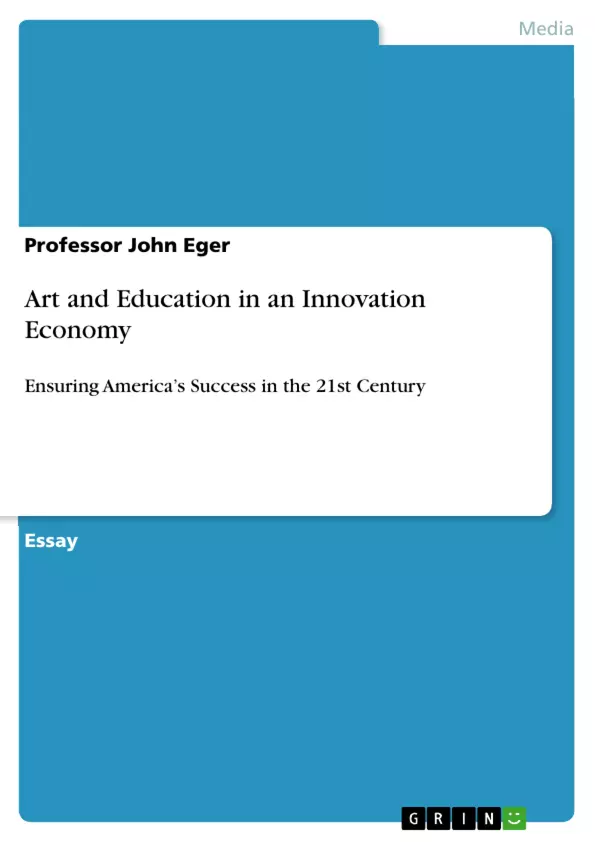According to Business Week Magazine: “The game is changing … it isn't just about math and science anymore (although those are surely important disciplines) it's about creativity, imagination, and, above all, innovation." 1
If creativity and innovation will be the hallmarks of the most successful communities in the 21st century we need to know the answers to the fundamental questions of what makes us creative, innovative, and imaginative.
The effort to create a 21st century community is not so much about technology as it is about jobs, dollars and quality of life. It is about organizing one's community to reinvent itself for the new, knowledge economy and society; preparing its citizens to take ownership of their community; and, most importantly, about educating the next generation of leaders and workers to meet the global, social, political and economic challenges we face.
This commentary focuses on education and the vital role of the arts in preparing our young people for a new and uncertain future.
Although many people still believe that the arts “are nice but not necessary,” it is becoming increasingly apparent that the arts are not a frill or an ancillary enrichment activity for elites. Indeed, they may be the most important aspect of a 21st century education. Our schools need the arts and an art-infused curriculum to ensure our children’s’ and our country’s competitiveness in the new global innovation economy.
Inhaltsverzeichnis (Table of Contents)
- INTRODUCTION
- AMERICA AT THE CROSSROADS
- THE GLOBAL INNOVATION ECONOMY
- REIMAGINING ARTS EDUCATION FOR THE 21ST CENTURY
- AN ARTS-INFUSED CURRICULUM
- ARTS AND INNOVATION
- WHY ARTS EDUCATION WORKS
- THE MISSING LINK
- CONCLUSION
Zielsetzung und Themenschwerpunkte (Objectives and Key Themes)
This white paper argues that arts education is crucial for the success of the United States in the 21st century, particularly within the context of a globalized economy driven by innovation. The paper explores the evolving economic landscape and highlights the role of arts education in preparing young people for this new environment.
- The importance of creativity and innovation in a globalized economy
- The challenges facing the United States in a globalized economy
- The role of arts education in fostering creativity and innovation
- The importance of arts-infused curriculum in schools
- The relationship between arts education and economic competitiveness
Zusammenfassung der Kapitel (Chapter Summaries)
- INTRODUCTION: This chapter sets the stage for the argument by discussing the concept of "smart communities" and the importance of creativity in the 21st century.
- AMERICA AT THE CROSSROADS: This chapter outlines the challenges facing the United States in a globalized economy, including the loss of manufacturing jobs and the rise of outsourcing.
- THE GLOBAL INNOVATION ECONOMY: This chapter explores the characteristics of the global innovation economy and emphasizes the need for creativity and innovation in this new environment.
- REIMAGINING ARTS EDUCATION FOR THE 21ST CENTURY: This chapter calls for a reimagining of arts education to prepare students for the global innovation economy, arguing that arts education is not a frill but an essential part of a 21st-century education.
- AN ARTS-INFUSED CURRICULUM: This chapter discusses the benefits of an arts-infused curriculum and argues that it can help students develop critical thinking, problem-solving, and communication skills.
- ARTS AND INNOVATION: This chapter explores the link between arts education and innovation, arguing that arts education can help students cultivate the creative thinking and problem-solving skills needed for innovation.
- WHY ARTS EDUCATION WORKS: This chapter provides evidence supporting the benefits of arts education, highlighting research that shows how arts education can enhance cognitive, social, and emotional development.
- THE MISSING LINK: This chapter argues that arts education is the missing link in preparing students for the 21st century economy.
Schlüsselwörter (Keywords)
This white paper focuses on arts education, innovation economy, globalization, creativity, critical thinking, problem-solving, and economic competitiveness.
- Quote paper
- Professor John Eger (Author), 2011, Art and Education in an Innovation Economy, Munich, GRIN Verlag, https://www.grin.com/document/169114



